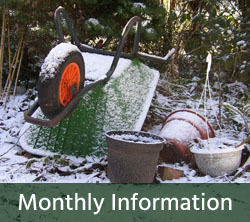
| Weather Averages February 1: High 42, Low 26 February 28: High 50, Low 32 Precipitation: 2.1 inches |
February Garden Calendar
Garden Help Desk
Master gardeners will take your gardening questions at the VCE Help Desk year-round. Give us a call. We will hopefully return to farmers markets in the near future.
Feed the Birds
Seeds and berries that are food for birds in the natural environment become scarce in February. For this reason, it is important to keep your bird feeders full this month. Scientific research has shown that black-oil sunflower seeds attract the most birds. White prove millet is another grain that birds like.
Trees and Shrubs
Deer protection
Commercial sprays have a good track record in repelling deer. Spray every two to four weeks, rotating among two to three products to keep deer from growing accustomed to the scents. For more information, see article.
Snow and ice protection
Snow and ice can damage shrubs with multiple leaders, such as arborvitae and juniper. To prevent branches from bending and breaking, use cloth, nylon or garden twine to tie the trunks together above weak crotches. Remove the ties in spring.
Winter injury prevention
Evergreen shrubs in exposed areas may suffer desiccation from northerly winds or damage from bright afternoon sun on the southwestern side of vertical trunks. Prevent both problems by surrounding the entire shrub or part of it with a burlap screen, making sure to leave the top open. Don’t use anti-desiccants, which have been found to be ineffective.
Pruning
The winter pruning season has arrived. Here is a partial list of trees and shrubs that may be pruned in February.
Deciduous trees
Beech, catalpa, crape myrtle, ginkgo, hickory, honey locust, linden, mulberry, black gum, oak, sourwood, stewartia, sweetgum, sycamore, tulip tree, zelkova. Engage a pro to prune large versions of these trees.
Evergreen trees
Cedar, cypress, fir, hemlock, evergreen holly, juniper, Leyland cypress, magnolia, pine, spruce.
Shrubs
Abelia, arborvitae, boxwood, butterfly bush, cherry laurel, clethra, cotoneaster, red-twig dogwood, gardenia, deciduous holly, juniper, nandina, osmanthus, photinia, privet, smoke tree, sumac, yew.
Prune all dead, damaged or diseased branches any time of the year.
Lawn
Because of the warm fall, you may have used your lawnmower right into December and did not a get a chance to service it. Don’t forget this important task because March is just around the corner. The mowing season is not far away. At the very least, your mower needs a sharpened blade and an oil change. It may need a new air filter and spark plug as well. And don’t forget that leaving gas in the mower’s fuel tank over the winter is a very bad idea. You may not be able to start it in the spring.
Vegetable Garden
Sanitation
Buy seeds this month to start inside. Broccoli, cauliflower, and cabbage will be started inside in early March for transplant outside in early April.
Fruits
Sanitation
Assuming you completed sanitation and rodent protection tasks in November, there is not much for you to do.
Do NOT prune fruit trees now; you will be pruning out the flower buds.
Flowering Annuals, Perennials
This is a good time to start acquiring seeds of flowering annuals to start inside.
Houseplants
Scouting for Pests
Don’t take your houseplants for granted. Inspect them regularly to detect the onset of pest problems. This month, you may begin to see small numbers of aphids, whiteflies, mites or mealy bugs. Keep the problems from exploding by bathing the plants in a spray of warm water or water containing an insecticidal soap. Make sure to wet all parts of the plant thoroughly. A cotton swab dipped in rubbing alcohol is good for removing small numbers of mealy bugs and aphids. Take care not to overdo it with the rubbing alcohol; too much will harm some plants.
Watering
Most houseplants should be watered when the surface of the soil feels dry. Add water until it runs out the bottom of the pot. If the soil has pulled away from the pot’s rim, it is much too dry. Soak the pot in a bucket of water to restore the proper moisture.
Light
We won’t have enough natural sunlight to promote plant growth until mid- to late-winter, when the sun is higher in the sky. Until then, use a grow-light to augment sunlight but for no more than 16 hours per day.
Temperature
You might be surprised to find that the temperature on your windowsill is five to 10 degrees colder than near your thermostat. Therefore, if you keep your house at 65 degrees, it is possible that windowsill temperature may be as low as 55 degrees on cold nights. Almost all houseplants originate from the tropics and do not respond well to cold. Nighttime temperatures of 55 degrees may be lethal to some plants such as African violets. Close the window shades at night and make sure your temperature-sensitive plants are on the warm side of the shades.
References
• A Guide to Successful Pruning, Shrub Pruning Calendar, VCE Publication 430-462, 2009
• A Guide to Successful Pruning, Deciduous Tree Pruning Calendar, VCE Publication
430-460, 2009
• A Guide to Successful Pruning, Evergreen Tree Pruning Calendar, VCE Publication
430-461, 2009
• Best rock salt and Ice Melts Review, Consumer Reports, February 2014,
ConsumerReports.org
• Choosing Appropriate Ice Melt Products, 2012, VCE
• Managing Winter Injury to Trees and Shrubs, VCE Publication 426-500
• Protecting Trees and Shrubs Against Winter Damage, University of Minnesota Extension